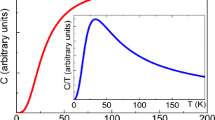The regular periodic intensity bursts recently observed in the expansion of solid 4He into vacuum have anomalies that have been attributed to a transition to some new solid phase induced by excess vacancies. Here it is shown that a small concentration of 3He, from 1% down to 0.1%, added to the 4He solid is sufficient to remove all the anomalies. The origin of the observed anomalies is discussed in the light of these new experiments.
Similar content being viewed by others
References
G. Benedek, F. Dalfovo, R. E. Grisenti, M. Käsz, and J. P. Toennies, Phys. Rev. Lett. 95, 095301 (2005).
E. Kim and M. H. W. Chan, Nature (London) 427, 225 (2004) [Science 305, 1941 (2004)].
Schuster I., Swirsky Y., Schmidt E.J., Polturak E., Lipson G.S., (1996). Europhys. Lett. 33, 623
Grisenti R.E., Toennies J.P., (2003). Phys. Rev. Lett. 90: 234501
It should be noted that the shape of the anomaly between 1.55 and 1.60 K depends on the previous history of the sample. It is generally sharp as in Fig. 2 for freshly prepared samples, but tends to be smoother after a few hours of measurements without a new heating/cooling cycle. The grain structure of the polycrystalline solid, the 3He segregation at grain boundaries as well as possible impurities, may play some role in this effect.
The measurement of the sample temperature T 0 with a stabilization of better than 10 mK is sufficiently precise to exclude that this sharp anomaly is related to the lower onset of the bcc phase of solid 4He. Vacancies are indeed much more mobile than in the hcp phase, but, as shown in Ref. 1 and in Fig. 4, the bcc phase is entirely contained in the region of the phase diagram where the vacuum expansions of pure 4He follows a Bernoulli’s regime. Although the measured temperature T 0 is that of the thermostat in contact with the source through a copper block, the fact that the regular geyser effect observed at constant P 0 > 31 bar1 switches on (off) with decreasing (increasing) T 0 exactly and reversibly at T 0 = T m (P 0) gives confidence that T 0 is a measure of the solid helium temperature in the source.
D. S. Miyoshi, R. M. Cotts, A. S. Greenberg, and R. C. Richardson, Phys. Rev. A 2, 870 (1970). These authors report the phase diagram for a 1.94% 3He concentration, where the melting line in the region of interest is shifted upward by ~1.3 bar and the upper hcp-bcc triple point is shifted to a lower temperature by about 0.1 K.
Fraass B.A., Granfors P.R., Simmons R.O., (1989). Phys. Rev. B 39, 124
Zuev N.V., Boiko V.V., Dyumin N.E., Grigorev V.N., (1998). J. Low Temp. Phys. 111, 597
Suzuki H., (1977). J. Phys. Soc. Jpn. 42: 1865
Carmi Y., Polturak E., Lipson S.G., (1989). Phys. Rev. Lett. 62: 1364
Rolley E., Guthmann C., Chevalier E., Balibar S., (1995). J. Low Temp. Phys. 99, 851
Pederiva F., Dalfovo F., Fantoni S., Reatto L., Stringari S., (1997). Phys. Rev. B 55: 3122
Burovski E., Kozik E., Kuklov A., Prokof’ev N., Svistunov B., (2005). Phys. Rev. Lett. 94: 165301
Sasaki S., Ishiguro R., Caupin F., Maris H.J., Balibar S., (2006). Science 313: 1098
Khairallah S.A., Ceperley D.M., (2005). Phys. Rev. Lett. 95: 185301
Galli D.E., Reatto L., (2001). J. Low Temp. Phys. 124, 197
Dai X., Ma M., Zhang F.-C., (2005). Phys. Rev. B 71: 132504
Prokof’ev N., Svistunov B., (2005). Phys. Rev. Lett. 94: 155302
Boninsegni M., Prokof’ev N., Svistunov B., (2006). Phys. Rev. Lett. 96: 105301
D. E. Galli, M. Rossi, and L. Reatto, Phys. Rev. B 71 140506(R) (2005).
Saslow W.M., (2005). Phys. Rev. B 71: 092502
Clark B.K., Ceperley D.M., (2006). Phys. Rev. Lett. 96: 105302
Author information
Authors and Affiliations
Corresponding author
Rights and permissions
About this article
Cite this article
Benedek, G., Grisenti, R.E., Käsz, M. et al. The Effect of 3He Impurities on Anomalous Oscillations in the Expansion of Solid 4He. J Low Temp Phys 146, 393–402 (2007). https://doi.org/10.1007/s10909-006-9273-x
Published:
Issue Date:
DOI: https://doi.org/10.1007/s10909-006-9273-x




